| Article ID | Journal | Published Year | Pages | File Type |
|---|---|---|---|---|
| 4112137 | International Journal of Pediatric Otorhinolaryngology | 2014 | 10 Pages |
ObjectivesThe present study focussed on validating the Screening Test for Auditory Processing (STAP) that contains four subsections: speech-in-noise, dichotic consonant vowel, gap detection and auditory memory. The sensitivity and specificity were ascertained by comparing the results of the screening test with that of diagnostic tests for auditory processing.MethodsThe STAP was administered on 500 school going children in the age range of 8–13 years. These consisted of 141 children who were found at-risk on the Screening Checklist for Auditory Processing (SCAP). Diagnostic APD tests (speech-in-noise, dichotic CV, gap detection and auditory memory) were administered on 152 of the children referred and/or passed on the screening procedures.ResultsThe results from the STAP indicated that the auditory memory subsection of the STAP was the most affected followed by dichotic CV and speech-in-noise. Gap detection was the least affected among the four subsections. A high and significant correlation was noted between the subsections of the STAP and the APD diagnostic tests. The sensitivity and specificity of the STAP on comparison with the diagnostic tests was found to be 76.6% and 72%, respectively. It was found that when a combination of SCAP and STAP was used for screening, the sensitivity and specificity were higher.ConclusionBased on the findings of the study, it is recommended that both SCAP and STAP be administered. Further, there was also a good test–retest reliability of the SCAP, STAP and the APD diagnostic tests.
